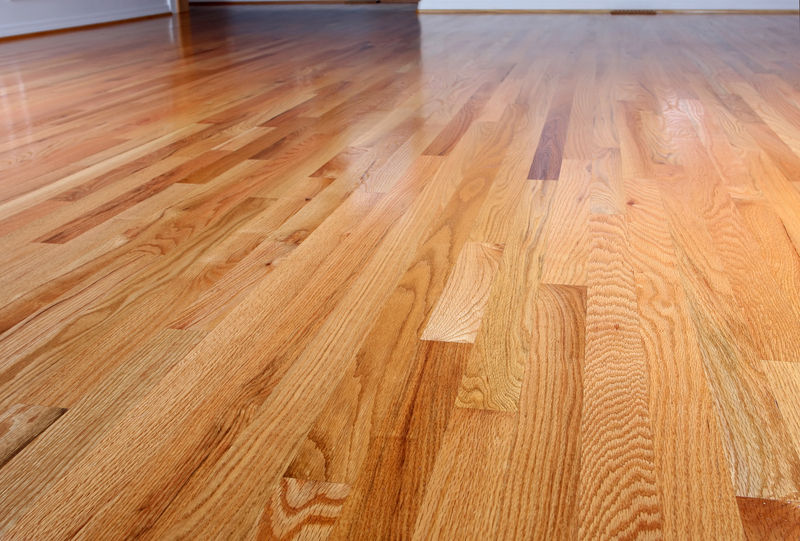Uncover the Best Methods for Stovetop Burnt-on Residue Removal
Posted on 05/06/2025
Uncover the Best Methods for Stovetop Burnt-on Residue Removal
Stovetop burnt-on residue removal is a household cleaning challenge most of us have faced at some point. After an intensive cooking session, spills and splatters can leave stubborn, hardened stains that seem impossible to clean. Understanding the most effective strategies for burnt-on cooktop residue removal not only restores your stovetop to its original shine but also ensures its longevity and optimal performance. In this comprehensive guide, we'll explore the best stovetop cleaning methods, including natural remedies, commercial cleaners, step-by-step procedures, and expert tips to tackle every kind of stubborn burn-on mess.
Why Is Burnt-On Residue So Tough to Remove?
Burnt-on residue is more than just an eyesore; it's a baked-on mix of food, grease, and sometimes even sugary substances that get fused to your stovetop when exposed to high heat. As these substances harden, they adhere strongly to the cooking surface. Not only does this make stovetop burnt residue removal more difficult, but it can also impact food flavor, create hygiene concerns, and reduce the visual appeal of your kitchen.
Common Types of Stovetops Affected by Burnt-On Residue
- Gas Stovetops: Grates and burners often collect spills that get baked on by open flames.
- Electric Coil Stovetops: Food drips onto the coils and beneath the pans, creating tough burnt spots.
- Glass/Ceramic Cooktops: Spills harden quickly on the flat, smooth surface, making scratches a risk during cleaning.
- Induction Cooktops: While generally easier to clean, improper technique can still lead to hard-to-remove stains.

Prevention: The First Step Toward an Easy Clean-up
The most effective way to deal with stubborn stovetop stains is to prevent them whenever possible. Here are a few smart habits to help you minimize burnt-on residue in the first place:
- Wipe Spills Immediately: Cleaning up messes while they're fresh prevents them from hardening.
- Use Splatter Guards: These keep bubbling sauces and frying oils from escaping pans.
- Watch Cooking Times: Keeping an eye on boiling liquids stops overflow before it happens.
- Protect Surfaces: For glass or induction tops, use mats or liners made specifically for stovetop protection (as approved by the manufacturer).
Even with diligent habits, accidents happen. Let's delve into the top techniques for removing burnt-on stovetop residue safely and effectively.
Essential Tools and Supplies for Burnt Residue Removal
Before starting any cooked-on residue removal process, gather these helpful items:
- Baking Soda: A gentle, natural abrasive ideal for scrubbing without scratching.
- White Vinegar: Effective at dissolving mineral residues and breaking down grease.
- Razor Blade Scraper: For glass and ceramic stovetops, these specialized tools safely lift stuck debris.
- Non-scratch Scrubbing Pads or Sponges: Essential for scrubbing without destroying the surface.
- Microfiber Cloths: Perfect for final polishing.
- Commercial Cooktop Cleaner: Especially formulated solutions for electric, glass, or ceramic stovetops.
- Plastic or Wooden Spatula: Handy for softening and gently scraping.
- Gloves: To shield your hands from chemical cleaners or heat.
Step-by-Step Guide to Stovetop Burnt-on Residue Removal
Step 1: Ensure The Stovetop Is Cool and Disconnected
Always let the stovetop cool completely before starting. If you have an electric or induction cooktop, unplug it or turn off the circuit breaker for added safety.
Step 2: Remove Loose Debris
Use a damp cloth or paper towel to wipe away crumbs and loose particles. This prepares the surface for deeper cleaning and helps avoid scratching.
Step 3: Apply a Baking Soda Paste
- Mix three parts baking soda with one part water to create a thick paste.
- Spread this paste generously over the burnt-on residue.
- Allow it to sit for 15-30 minutes, giving the baking soda time to break down the bonds.
Step 4: Use White Vinegar for Added Lifting Power
- Spray or gently pour white vinegar over the baking soda paste.
- The resulting fizzing action helps lift and dissolve tough stains.
- Let it bubble for several minutes.
Step 5: Gently Scrub the Surface
- With a non-scratch sponge or scrubbing pad, gently scrub the area in circular motions.
- For glass or ceramic tops, use minimal pressure to avoid scratches.
Step 6: Use a Razor Blade Scraper (for Glass or Ceramic Stovetops)
- If residue persists, hold a razor blade scraper at a 45-degree angle and carefully push it under the burnt spot.
- Only use this method on glass or ceramic; never use metal on metal stovetops.
- Be sure to check your manufacturer's guidelines first.
Step 7: Rinse and Buff Clean
- Wipe the cleaned area with a moist microfiber cloth to remove all paste and debris.
- Dry the surface, then buff with a clean, dry cloth for a streak-free shine.
Natural and Eco-Friendly Burnt Residue Cleaning Solutions
If you prefer to steer clear of harsh chemicals, there are several natural stovetop cleaning methods that are both effective and eco-friendly:
Lemon Juice
The citric acid in lemon juice breaks down mineral deposits and burnt-on organic residue.
- Squeeze fresh lemon juice onto the affected area and let it sit for 10-15 minutes.
- Wipe clean, repeating as necessary.
Hydrogen Peroxide and Baking Soda
Pour a small amount of hydrogen peroxide over the burn mark, sprinkle with baking soda, and let it fizz. This combination is excellent for extra-stubborn stains.
Cream of Tartar
Make a paste with cream of tartar and water. Spread on stains, let sit, and gently scrub clean.
Salt Scrub
While coarse salt can be abrasive, it's useful on metal grates or burners (never glass). Mix salt with a few drops of dish soap and water. Scrub, rinse, and dry.
Commercial Cleaners for Burnt-On Residue Removal
Sometimes, natural solutions need a boost. For stubborn stovetop stains that just won't budge, try these highly rated commercial options:
- Bar Keepers Friend: Safe for most stovetops, this cleaner tackles mineral deposits and cooked-on grime.
- Weiman Cooktop Cleaner: Specially formulated for glass and ceramic surfaces.
- Cerama Bryte: Ideal for ceramic and glass cooktops; often recommended by appliance manufacturers.
- Mr. Clean Magic Eraser: Gentle yet effective micro-scrubbing technology for spot cleaning (always test a small area first).
Always follow the manufacturer's instructions and test any cleaner on a small, inconspicuous area before full application.
Special Stove Parts: Burners and Grates
How to Deep Clean Burner Grates
- Remove grates and soak in hot, soapy water for 30 minutes.
- Use a brush or non-scratch pad to scrub away loosened residue.
- For extra-tough spots, make a paste of baking soda and water and apply overnight before scrubbing off.
- Dry thoroughly before replacing to avoid rusting.
Burner Heads and Drip Pans
- Soak drip pans in hot, soapy water.
- Scrub with a non-abrasive cleaner.
- For serious carbon deposits, use a mixture of vinegar and baking soda, or a commercial degreaser designed for stove parts.
Tips to Avoid Scratching and Damaging Your Stovetop
- Never use steel wool or metal pads--they can permanently scratch the surface.
- Always use the correct scraper for your stovetop type.
- Follow the manufacturer's cleaning and care recommendations to maintain warranties and ensure safe performance.
- Dry thoroughly after cleaning to avoid streaks, water spots, or rust on metal components.
Alternative Methods for Serious Burnt-On Residue
Baking Soda and Boiling Water Technique
- Sprinkle baking soda directly on the residue.
- Carefully pour a small amount of boiling water over the spot.
- Let sit until cool, then wipe away residue with a sponge.
Dishwasher Tablets
- For glass and ceramic stovetops, wet a dishwasher tablet and gently rub the residue until it lifts. Rinse clean.
Expert Advice: When to Call a Professional
If your efforts are unsuccessful or you face thick, carbonized layers that won't budge, it might be time to contact an appliance cleaning professional. They have chemicals and tools designed specifically for intensive stovetop restoration without risking damage to your appliance.

Frequently Asked Questions About Stovetop Burnt-On Residue Removal
1. Can I use oven cleaner on my stovetop?
*Oven cleaner* is often too harsh for most stovetops and can cause discoloration or damage, especially on glass or ceramic surfaces. Stick to products labeled specifically for cooktop use.
2. Is it safe to use vinegar on all types of stovetops?
Vinegar is safe for many cooktops, but always consult your appliance manual. Some manufacturers caution against vinegar for certain glass or induction models.
3. How often should I deep clean my stovetop?
Ideally, wipe down the surface after every use and deep clean at least once a week if you cook often.
Conclusion: Restore Your Stovetop's Shine with the Best Burnt-On Residue Removal Techniques
Burnt-on residue may seem daunting, but with the best stovetop residue removal methods, it's manageable. Whether you opt for eco-friendly solutions like baking soda and vinegar, or choose purpose-built commercial cleaners, consistent care and immediate attention to spills will keep your stovetop looking like new. Follow this guide, and your kitchen will always be as clean and inviting as the food you prepare.
Remember: Always prioritize safety, proper tools, and the recommended solutions for your cooktop's material. For the hardest jobs, don't hesitate to seek professional help. With these comprehensive methods for burnt-on residue removal, your stovetop will stand the test of time and culinary adventure.
- Share your stovetop cleaning tips or success stories in the comments below!
- Bookmark this page for quick reference whenever you need a refresher on deep cleaning your stove!




